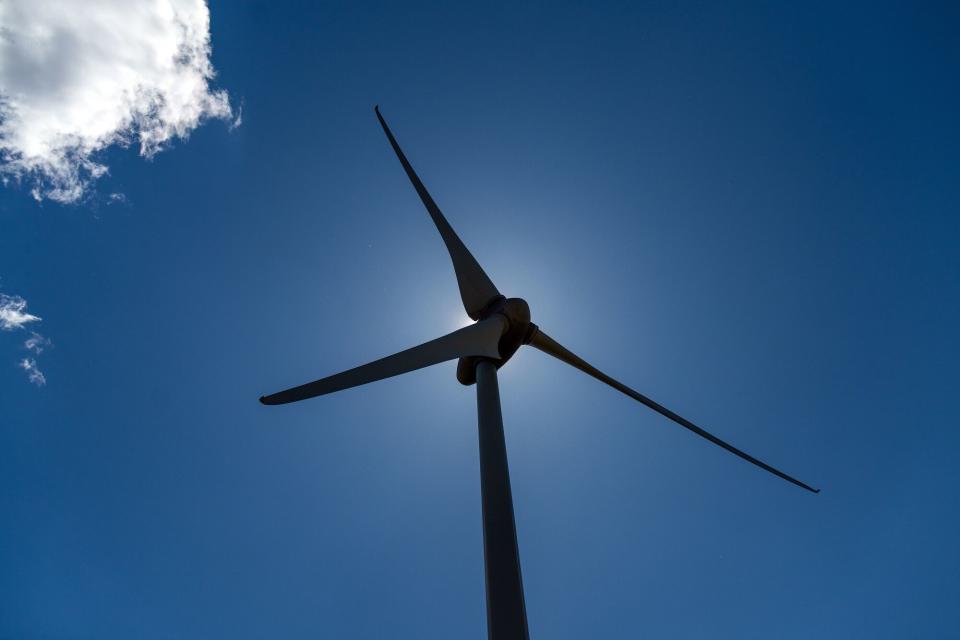Bill Gates-Backed Company Is Redesigning the Wind Turbine

(Bloomberg) -- Wind turbines have grown in size, but their form has largely stayed the same. A startup backed by the US Department of Defense and Bill Gates is among those looking to change that.
Most Read from Bloomberg
Urban Heat Stress Is Another Disparity in the World’s Most Unequal Nation
From Cleveland to Chicago, NFL Teams Dream of Domed Stadiums
Singapore Ends 181 Years of Horse Racing to Make Way for Homes
Chicago’s $1 Billion Budget Hole Exacerbated by School Turmoil
Airloom Energy Inc. received $13.75 million in financing to build a pilot in Wyoming to test its technology, the company announced on Tuesday. Lowercarbon Capital led a funding round that included Gates’s Breakthrough Energy Ventures LLC for $7.5 million, with the rest coming from the state of Wyoming and the Department of Defense.
Instead of rising on a tower, the startup’s turbine uses a rollercoaster-like track. Wind pushes wings around the structure, which in turn pull a belt that powers generators to produce electricity.
It’s a redesign that’s intended to deliver equipment that’s significantly smaller than horizontal axis wind towers, lowering the costs of construction and transportation, according to Chief Executive Officer Neal Rickner. The systems could potentially produce power at about a third of the cost of traditional turbines, he said.
Airloom’s system would be 10 to 30 meters tall (30 to 100 feet) tall, compared to regular turbine heights of about 100 meters, though positioning the system closer to the ground also means a loss of wind strength.
“We're a lot less expensive, and we make a little bit less energy,” he said.
Efforts to rethink wind turbine design come as the sector continues to grapple with the impact of supply chain snarls and higher interest rates that have stalled projects and seen the technology’s growth lag far behind solar installations.
Other potential innovations — including miniature, fan-like turbines or vertical-axis designs — have so far struggled to gain wide adoption, and industry leaders have focused on delivering increasingly powerful systems. China’s Ming Yang Smart Energy Group Ltd. last year announced a 22-megawatt turbine with a rotor diameter of more than 310 meters — meaning blades stretch nearly the height of the Eiffel Tower.
Rickner previously worked at Makani Technologies LLC, a wind energy company acquired by Alphabet Inc. that sought to use kitesurfing technology. The team behind it struggled to bring costs down, leading to the endeavor folding in 2021.
Alternative wind startups are usually an automatic pass, said Clay Dumas, founding partner at Lowercarbon Capital. However, Airloom’s approach promises to lower the cost and time for installations — and to be less obstructive.
“There's a lot of novelty in what Airloom is trying to do, but there's not a lot of novelty in the equipment or technology that they're taking off the shelf and assembling in new ways to generate wind power,” Dumas said.
With new Inflation Reduction Act tax credits coming into effect in 2025, the market for wind energy in the US is expected to significantly increase, said Oliver Metcalfe, head of wind research at BloombergNEF. In the US, wind energy capacity will more than double by 2035, according to BNEF’s forecast. Airloom’s shorter system could potentially benefit as it’s likely to avoid some permitting restrictions related to height, Metcalfe said.
“The really slow and arduous permitting processes, high costs to connect to the grid or queues to get a grid connection agreement, those non-economic factors are holding back the growth of the wind power sector more than simply the cost of energy,” he said.
Some permitting difficulties are related to height restrictions, and Metcalfe said Airloom’s shorter system could be a boon. But he said that success will depend on the full-scale demonstration showing that the company can deliver low-cost energy.
“The world is full of very smart engineers that can build innovative and exciting designs for harnessing wind energy, but the dominant design today is now very low cost in many markets around the world,” he said.
Airloom’s technology could win a role in areas with height restrictions — like airports and mountains — or where views need to remain unspoiled. The potential for use on military bases has attracted a $1.25 million investment from the Department of Defense, Rickner said.
The US Army aims to have a microgrid at every base by 2035 and have enough renewable energy to self-sustain critical missions at all bases by 2040. Large turbines are difficult to construct and transport, and can impact radar detection and where helicopters can fly.
Airloom plans to break ground on its pilot in 2025.
(Updates with BNEF wind forecast for the US in paragraph 12. A previous version corrected Lowercarbon Capital’s name in paragraph 2.)
Most Read from Bloomberg Businessweek
Hamas Struck Israel to Spark a Wider Conflict. A Year Later, It’s Got One
Rotting Rice in India Fuels Discontent About Modi’s Food Policy
©2024 Bloomberg L.P.